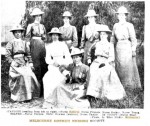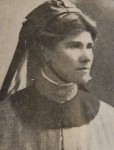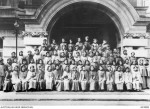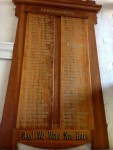ROBERTS, Annie Florence
Annie Florence Roberts (1879–1958)
Introduction
Annie Florence Roberts was born to John and Emma Roberts in Maryborough. She trained as a nurse at the Ballarat District Hospital then undertook additional training in infectious diseases at Fairfield in Melbourne. By the time she enlisted in 1915, she had worked for the District Nursing Society organisations in Melbourne and Ballarat, as well as running wards at the Ballarat Hospital and the hospital in Ararat.
Roberts spent much of her war service at sea, completing four round trips between Egypt or England and Australia in just 12 months. Affected by the heat she requested a transfer and (strangely) was sent to India. For almost a year she was in charge of nurses on the ship 'Ellora', which transported troops, often severely ill, from the campaign in Mesopotamia (Iraq) to hospitals in and near Bombay (now Mumbai). She was promoted and decorated with the Royal Red Cross (2nd Class) for her service in India.
After the war, she continued to nurse and was for a time matron of her old training hospital in Ballarat. From 1930, her address changed frequently, suggesting she moved to rooms near her various nursing positions in Melbourne and NSW.
Annie Roberts died in Heidelberg Repatriation Hospital near Melbourne in 1958.
She is commemorated on the Honour Board at St Peter's Church Eastern Hill in East Melbourne and with her brothers in the Ballarat Avenue of Honour (as Annie R Robert) and the Mt Egerton Primary School Roll of Honour.
+++
Before the War
Annie Florence Roberts was the second of 10 children (6s, 4d) born in 1879 to Welsh-born John Cymro Roberts (1845–1910) and his English wife Emma (nee Cornish) (1853–1923). The couple’s marriage was registered in 1878.
Annie and her 7 surviving siblings were raised in (Mount) Egerton, an historic gold mining town 100 kms north west of Melbourne. Their father John was clerk and time-keeper at the old Egerton mine for several decades, before moving to similar work at the Birthday Mine 70 kms away in Berringa (Age, 25.2.1902, p7). He was well-known in the Egerton community for his fine singing voice heard at numerous fund-raising and social entertainments.
The Roberts children were educated at the Mount Egerton State School which opened in 1877.
Louisa, Annie’s older sister, was a bright scholarship student who did higher grades at the Mount Pleasant State School near Ballarat. She studied at the Ballarat School of Mines in the early 1900s before becoming a school teacher (Ballarat Star, 8.3.1892, p4, 17.1.1902, p6).
Annie followed her sister to Ballarat where she trained as a nurse. She completed her three year certificate in 1904 at the District Hospital and the Royal Victorian Trained Nurses Association requirements in 1905. She also completed a certificate in infectious diseases at the Queen’s Memorial Infectious Diseases Hospital in Fairfield, Melbourne.
Over the next few years Roberts accumulated considerable experience in both hospital and district/community nursing. She was sister in charge of various wards at Ballarat District Hospital for three years and then matron of the hospital at Ararat from 1912 to 1914.
For several years (c1906–08), Annie Roberts worked for the Melbourne District Nursing Society, the first organisation of its kind in Australia. She and the other district nurses travelled around inner Melbourne on bicycles, providing nursing care to needy patients in their own homes and making referrals to the Society’s team of lady visitors. It was during this time that Annie would have attended St Peter’s Church, Eastern Hill, drawn by the number of nurses in the congregation and by the interest of the clergy in their spiritual well-being through the St Barnabas Guild.
It was also during this time, in April 1908, that Annie Roberts was caught up in a fatal train crash near Sunshine on Melbourne’s western outskirts. A passenger with her sister and a ‘gentleman friend’ on the train from Ballarat, she found herself in the midst of a chaotic scene of smashed carriages and protruding limbs, surrounded by the groans and cries of dying and injured passengers. She rendered what assistance she could, telling a reporter, ‘I hope I shall never witness such a sight again.’ (Weekly Times, 25.4.1908, 32).
In early 1914, she resigned from Ararat Hospital to work for the Ballarat District Nursing Society. Like the Melbourne prototype it provided nursing care for the sick poor in their own homes, together with medicine, bed linen, clothing and nourishment furnished by the ladies committee. Roberts was warmly welcomed with her high credentials. Over the course of the 1913-14 year, the Society paid 1260 visits to 97 patients with ‘almost every ailment – cancer, tuberculosis, pneumonia, phthisis, paralysis senility and heart cases’ (Ballarat Star, 1.8.1914, p10).
During the War
On 4 August 1914, Britain declared war on Germany and as part of the Empire, Australia followed suit. Among the early volunteers were Annie’s 20 year old brother Clarence who enlisted on 18 August (Service Number 289), and Annie herself who immediately sought leave from the Ballarat District Nursing Society to enlist in the Australian Army Nursing Service (Ballarat Courier, 30.7.1915, p1).
Clarence, an architectural draftsman and in the midst of his compulsory training in the militia, embarked with the 8th Battalion on 9 October 1914 (Clarence Rupert Roberts, Service Record [NAA]). He fought on the Gallipoli peninsula, was wounded and evacuated by ship to Valetta in Malta. Burnt and shot, he died of septicaemia there on 13 August 1915, shortly after his leg was amputated. He was buried on Malta.
It was almost a year from her initial intention before Annie Roberts could formally enlist in the AANS. She embarked on the Orsova in Sydney on 17 July 1915 with other reinforcements for 2 Australian General Hospital.
Among the nurses was Catherine (‘Kit’) McNaughton whose account of the voyage has been wonderfully recounted in Janet Butler’s biography, Kitty’s War: The remarkable wartime experiences of Kit McNaughton (UQP, 2013). From Kit’s diary emerges the magnitude and horror of the deluge of casualties from the Gallipoli campaign that confronted the nurses. They had never seen either the volume of patients nor the type of injuries (Butler, Kitty’ War, Ch.2).
Weeks later, Roberts was on her way back to Australia as a nurse on the hospital ship Kanowna with sick and wounded troops. The trip was a way of returning to her grieving mother in Ballarat and gave her the opportunity to see her brother’s grave in the Pieta Military Cemetery when Kanowna boarded passengers from hospitals on Malta. She visited the grave again in 1916 and as on the first occasion left deeply gratified at the care taken throughout the cemetery (Clarence Roberts, Service Record [NAA]).
The Kanowna left Suez on 20 October and reached Australia a month later. A coastal steamer, Kanowna had been quickly (but incompletely) refitted in England to carry invalided soldiers. Its facilities included an operating theatre, xray department, wards and equipment, stores and comforts. Patients included men with infectious diseases such as diphtheria and recovering from typhoid, as well as battle casualities. Some were bedridden but most were ambulant with assistance. As the press noted, it was the first time wounded men had been transported in appropriate facilities – ‘as far as possible the conditions pertaining in a modern hospital are reproduced’ (Australasian, 27.11.1915, p.35). Three men had died on the voyage and a dozen stretcher cases were off-loaded in Melbourne. The Argus reported on the ship in detail (Argus, 23.11.1915, p.6).
After a month for further refitting and restocking with medical and nursing stores and comforts – everything from motor ambulances to cigarettes – Kanowna left Australia again at Christmas time 1915. Roberts was again on board, now promoted to sister, having undoubtedly been reunited with her mother, sisters and brothers and described to them Clarence’s grave – something she said that gave her mother great peace of mind (Clarence Roberts, Service Record).
Annie Roberts was on the Kanowna’s next return voyage which reached Australia in March 1916. Once again, its arrival excited public interest and was widely reported. The Melbourne press described a deceptively happy scene: ‘the soldiers looked happy and contented as they were driven through the cheering crowd which lined the city streets’ (Argus, 11.3.1916, p.17).
Just as the scene belied the soldiers’ conditions, so did hospital transport duty belie the dangers for the ships, their crews and their passengers. Being painted prominently as a hospital ship did not guarantee safety from enemy attack: several British hospital ships were torpedoed and sunk between 1916 and 1918. Life jackets were worn when required and boat drills part of the routine. In addition there were all the challenges of nursing duties in a confined and unpredictably moving space (see Kirsty Harris, Red Reflections on the Sea: Australian Army Nurses serving at Sea in World War 1, Journal of Australian Naval History, 2009, Vol. 6 No. 2, pp 51-73).
Annie Roberts made four round trips (Australia to England/Egypt and return) in just twelve months between October 1915 and October 1916, several as part of the dedicated specialist Sea Transport Section, deliberately created for the transport of invalided troops. She returned to Australia in November 1915, March 1916, June 1916, August 1916 and October 1916. The four to five week voyages were punctuated with a fortnight’s leave before re-embarking. The work and its context were both specialized and exhausting, but the trips did allow her to visit her brother’s grave again.
After four trips, Roberts felt that her health had been so affected by the heat encountered in numerous equatorial crossings she requested a transfer (Roberts, Service Record). Ironically, she was sent to India, arriving in Bombay (Mumbai) on the SS Mooltan in mid January 1917. She was posted to the Victoria War Hospital there, one of four in the city. The 600 bed hospital was a four storey modern building close to the docks for easy transport of patients brought by ship. The patients were primarily troops from the campaign in Mesopotamia (Irag), seriously ill because of dysentery, malnutrition and/or septic wounds, and transported from the battle fields to India under the most trying conditions by barge and then hospital ships such as the Ellora.
India was the destination of 20% of the AANS who served but it was not a declared a theatre of war, a source of frustration to many who longed to be closer to the action. (For the AANS in India, see Ruth Rae, Reading between unwritten lines: Australian Army Nurses in India, https://www.awm.gov.au/journal/j36/nurses/; M. Barker, Nightingales in the Mud: The Digger Sisters of the Great War (1989)). British hospitals in Bombay (Mumbai), Deolali and Poona with staffed by British medical officers; matrons and nurses were predominantly Australian.
For the second time Roberts’ posting to a conventional war hospital was brief. With her vast experience of nursing on hospital ships, after six weeks at the Victoria Hospital she was appointed matron on the hospital ship Ellora. HS Ellora was a key ship on the routes from the East African coast (German and Italian colonies). It carried sick and wounded British and Australian troops, and Italian and Turkish prisoners of war.
Roberts made no fewer than 13 trips between the Persian Gulf ports and Bombay in the course of a year. She was awarded the Royal Red Cross (2nd Class) for her work on the hospital ships.
Eventually the heat and travel affected her health again (Ballarat Star, 19.7.1918, p3; Ballarat Star, 17.5.1919, p1). In early 1918, Roberts was appointed matron of a small hospital for convalescent officers at the Nasik Hill station, four hours east of Bombay. It was a dramatic contrast to her two years of sea transport work: life in comfortable bungalows with electricity and other comforts, three nurses on the staff, and homely (Barker, Nightingales in the Mud, p. 79). She was there for the remainder of the war and beyond, until she left Bombay in April 1919.
After the War
Robert returned to Australia in May 1919 and was soon back in Ballarat with her mother and other family. She was 40. It would be some months before David, her other brother in the AIF who had enlisted in 1917 and served on the Western Front, returned from England in November 1919.
Annie Roberts was welcomed warmly by her old employer, the Ballarat District Nursing Society, who showered her with their pride, praise and gifts (Ballarat Star, 17.5.1919, p1).
Roberts did not turn to either repatriation nursing or the burgeoning field of infant welfare as many of her AANS colleagues did after the war. In the 1920s and early 1930s she was matron of several country hospitals. She was appointed to Wangaratta Hospital in 1922, returned to Ballarat Hospital to replace the matron who had been dismissed in 1924, then returned to Wangaratta in 1925 for two years (Benalla Standard, 14.2.1922, p3; Argus, 21.7.1924; Table Table, 31.12.1925, p43). In early 1929, she was matron of the Hay Hospital in the Riverina district of NSW, a position she held until she returned to Melbourne in 1930 to take up a matron’s position in Fitzroy (Age, 27.12.1927, p16; Riverina Grazier, 12.2.1929,p2, 7.2.1930, p4).
In the 1930s, Roberts lived mainly in the inner suburbs of Melbourne, her address on the electoral roll changing frequently, perhaps as she moved to accommodation close to where she was nursing. In 1934, she was (matron) at the convalescent home associated with the Freemasons cottages in Prahran, and around 1937 she returned to NSW as matron at The Armidale School, a public boys school on the English model but then enduring the harsh impact of the depression.
In the 1940s, aged in her sixties, Anne Roberts lived in rented flats or rooms in South Yarra. In 1951, she wrote to the Edith Cavell Trust Fund for sick and indigent army nurses seeking a grant for ‘necessities’, but returned the £30 grant stating it was not required (Edith Cavell Trust Fund, M291 [NAA]).
Annie Roberts died on 18 July 1958, at Heidelberg Repatriation Hospital, Melbourne. Her cremated remains are in the Springvale Botanical Cemetery, Springvale, Melbourne.
She is commemorated on the Honour Board at St Peter's Church Eastern Hill in East Melbourne and with her brothers in the Ballarat Avenue of Honour (as Annie R Robert) and the Mt Egerton Primary School Roll of Honour.
Janet Scarfe
Adjunct Research Associate
15 September 2016





